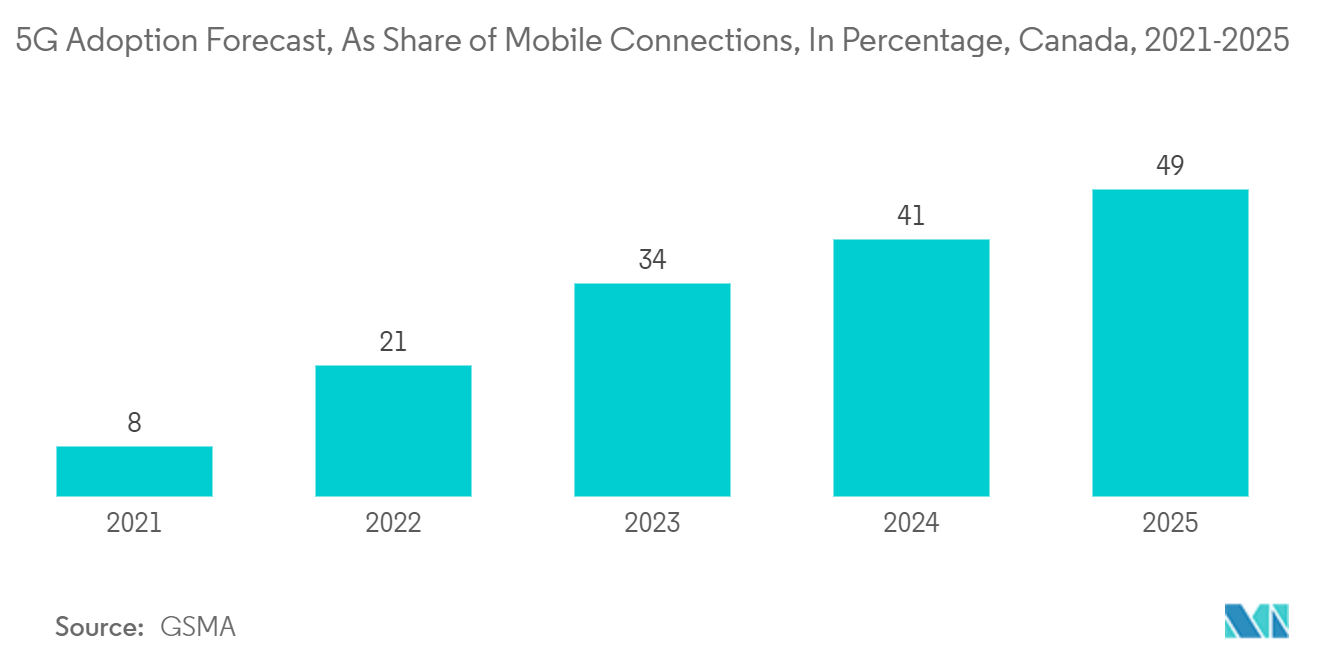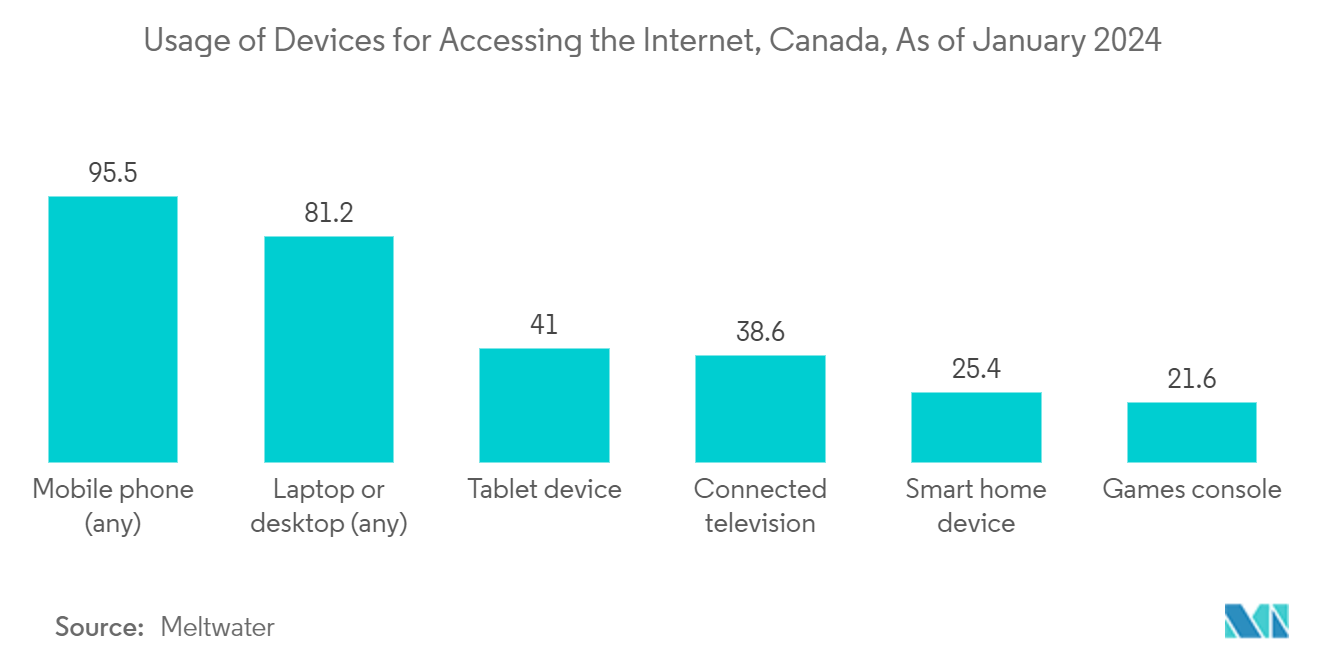Market Trends of Canada Data Center Cooling Industry
The IT and Telecommunication Segment Holds the Majority Share
- With the ongoing expansion and enhancement of 5G networks, the stage is set for the rise of emerging edge applications. These applications demand swift, high-capacity data transfers and, in turn, produce substantial heat. In response, major service providers are pivoting toward advanced data center cooling solutions to bolster their automation capabilities.
- In May 2024, Telus announced a USD 73 billion investment over the next five years, focusing on bolstering its broadband and 5G networks across Canada. Of this, approximately USD 33 billion is earmarked for BC and Alberta, with BC set to receive a USD 17 billion boost, specifically for enhancing Telus' 5G network. Additionally, the company revealed plans to double its cell tower constructions in 2024 compared to 2023.
- According to Opensignal Limited, download speeds for Bell, Rogers, and Telus rose from 158.7 Mbps, 130.7 Mbps, and 138.3 Mbps, respectively, in February 2023 to 196.2 Mbps, 158.6 Mbps, and 169.2 Mbps, in February 2024.
- Telecommunications have evolved and started using hybrid cloud structures, combining both public and private cloud structures. The usage of this hybrid cloud structure helps telecommunication companies manage the sudden surge in traffic. The implementation of hybrid cloud services helps the telecom industry deploy its cloud services instantly, leading to lower downtime. The increased bandwidth speeds raised data consumption on mobiles from 1.5 GB in 2016 to 5.2 GB in 2023. The consumption is expected to reach around 8.6 GB by 2029. Such instances in the market are expected to create more need for data centers, boosting the demand for data center cooling infrastructure in the coming years.
- Furthermore, in response to the surging demand for cloud services, public players in the country are actively modernizing their offerings. Highlighting this trend, Oracle and Google Cloud unveiled a partnership in June 2024. This collaboration empowers customers to seamlessly integrate Oracle Cloud Infrastructure (OCI) with Google Cloud technologies, facilitating quicker application migrations and modernization. These developments underscore the escalating demand for cloud adoption in the market.

Liquid-based Cooling is Expected to be the Fastest Growing Segment
- In data centers, liquid cooling offers many benefits and is an attractive option for cooling computing environments with high performance. Liquid cooling appears to be more energy efficient compared to conventional air conditioning. It reduces the need for overcooling and improves the energy efficiency of data centers by providing precise temperature control.
- In terms of technology, liquid-based cooling is the fastest-growing segment in Canada. In liquid cooling technology, direct-to-chip held the maximum market share in 2023. The direct-to-chip sub-segment is expected to hold a significant share of the market over the forecast period. The past few years have noticed an escalating adoption of cloud services delivered by a network of highly competitive providers. Google Cloud, Microsoft Azure, Amazon Web Services, and IBM Cloud have expanded their operational capacities, generating more demand for direct liquid cooling solutions for data centers.
- In March 2024, Accelsius, known for its patented direct-to-chip liquid cooling systems that enhance high-performance computing and compute density for data center and edge computer operators, announced a strategic partnership with Equus Compute Solutions (ECS). This collaboration aims to address the growing demand for advanced liquid cooling solutions in data centers. As a component of Accelsius’ Accelerate Partner Program, this partnership facilitates the transition from air to liquid cooling. The program unites top-tier systems integrators, OEMs, cooling solution experts, and other IT providers across data centers in the United States and Canada.
- Technologies such as artificial intelligence and machine learning are integrated into liquid cooling systems to optimize cooling efficiency and anticipate maintenance needs. They facilitate the efficient operation of data centers and help reduce their downtime.
- Technological advancements have helped reduce the water consumption of data centers by more than 15% in tropical climates and 80% in green areas, making liquid cooling easier to maintain, scale up, or affordable. Energy used for liquid cooling can be recycled to heat buildings and drinking water, while advanced artificial refrigerants can significantly reduce the carbon footprint of air conditioners.
- The country plans to develop more smart cities, integrating IoT, 5G, blockchain, AI, and other cutting-edge technologies, resulting in more significant data generation. For instance, as of January 2024, 95.5% of Canadian internet users accessed the web via mobile phones. Following closely, laptops and desktops, whether personal or employee-issued, emerged as the second most popular devices for online access.
- Moreover, the proportion of 5G users is projected to surge from 7% in 2021 to approximately 62% by 2025. This rise is set to drive both data consumption and the evolution of networks during the forecast period. As the market witnesses these advancements, data centers are expanding, leading to a heightened demand for DC cooling infrastructure in the country.


